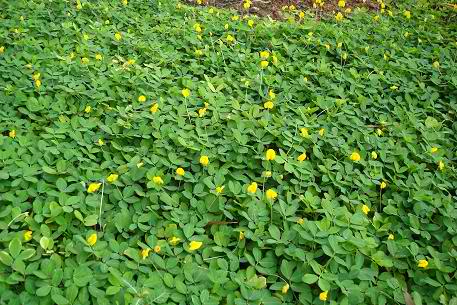It looks like peanut but it’s not. This is Arachis pintoi a landscaper’s favorite for home gardens and landscapes of institutions, theme parks, botanical gardens, golf courses, roadsides, resorts, pathways, and many more.

A. pintoi is related to the peanut food legume (Arachis hypogaea) and is a forage legume that has become more than just a feed source for animals.
Its stunning yellow flowers or florets and dense clover-shaped foliage provide a spectacular aesthetic value among gardeners and plant enthusiasts earning it the moniker “golden glory”.
Arachis what?
Arachis pintoi is one of the forage legumes considered in the livestock and poultry industry as a protein-fiber source component in the animal diet. It is very good for native or free-range chicken and ducks. Pigs can also be fed with Arachis. For ruminants, it is recommended for cut-and-carry system and as supplement or component with grass and tree leaves. It has a nutritive value of 13?25% crude protein and 60?70% dry matter digestibility.
Popularly known among local gardeners as peanut plant, arachis, and “mani-manian”, among other names, it is believed to have come from South America, domesticated and further developed through research.
The plant was introduced to the Philippines in the 80s through foreign-funded feed resource and forage projects.
With its very unique characteristics and uses, its popularity has grown since then. Aside from being a very good source of high quality protein feed for the livestock diet, it can also be used as cover crop to control weeds.
Studies also show that Arachis improves soil fertility and condition. The plant spreads fast, thus easily covering the ground and thus helping control soil erosion.
Since Arachis is a relative of the food peanut, it produces seed underground making harvesting of its seed is difficult. But the plant can be established through seed provided good seed is available. In fact, the plant also grows even in moderately fertile soils but best suited to the wet with short or no dry season.
One of the limitations of Arachis is that it cannot withstand heavy grazing and high animal stocking rate. However, this is not a concern of landscape architects who use the Arachis for a different purpose.

